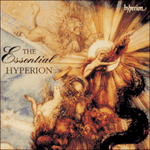
Welcome to Hyperion Records, a British classical label devoted to presenting high-quality recordings of music of all styles and from all periods from the twelfth century to the twenty-first.
Hyperion offers both CDs, and downloads in a number of formats. The site is also available in several languages.
Please use the dropdown buttons to set your preferred options, or use the checkbox to accept the defaults.

The work is, most unusually for the eighteenth century, a black comedy, set throughout in a tomb. It is based on an episode from The Satiricon by Petronius, which Bickerstaffe might have encountered in the Jacobean play The Widow's Tears by George Chapman, in an unpublished contemporary play by Charles Johnson, in many popular chapbooks, or in a well-known essay by Steele in The Spectator; Bickerstaffe clearly knew the latter, for he borrowed from it the motif of the traveller, the lion and the signpost for his vaudeville. The Ephesian Matron has just become a widow and, despite the pleadings of her father and maid, is determined to remain with the body until death. She expresses her grief in a delicious parody of the mad arias of contemporary opera seria. The maid tries without success to cheer her up in a patter song, but soon after a handsome Roman centurion arrives who has been guarding the bodies of executed criminals nearby. He has considerably more success but returns to his post, only to find that a body has been stolen. He returns distraught, but the Matron has an inspiration: her husband's body will replace the missing one. A wedding is the inevitable outcome, after the period of mourning has been swiftly reduced in the last recitative from seven years to one day. In the vaudeville the four singers step out of character to apologise to women for the way they are traditionally represented as false, vain and changeable.
from notes by Peter Holman © 1992
Chose peu habituelle au XVIIIe siècle, c'est une comédie noire, dont toute l'action se passe dans un tombeau. Elle est basée sur un épisode du Satiricon de Petronius, que Bickerstaffe aurait pu trouver dans une pièce de l'époque de Jacques Ier , The Widow's Tears ('Les larmes de la veuve'), par George Chapman, dans une pièce contemporaine de Charles Johnson jamais publiée, dans de nombreux tracts de colporteurs ou dans un essai bien connu de Steele dans The Spectator; Bickerstaffe connaissait certainement ce dernier car il lui emprunta le motif du voyageur, du lion et de l'enseigne pour son vaudeville. La matrone d'Ephèse vient de devenir veuve et, malgré les supplications de son père et de sa servante, elle a décidé de rester avec le corps de son mari jusqu'à sa propre mort. Elle exprime sa douleur dans une délicieuse parodie des airs de folie des opera seria contemporains. La servante essaie en vain de la consoler dans un air en style parlé, mais bientôt arrive un beau centurion romain qui gardait les corps de criminels exécutés, non loin de là. Il a beaucoup plus de succès, mais retourne à son poste et constate qu'on a volé un des cadavres. Il revient, affolé, mais la Matrone a une idée de génie: le corps de son mari remplacera le cadavre volé. Un mariage est la conclusion inévitable et la période de deuil est rapidement réduite, au cours du dernier récitatif, de sept ans à une journée. Dans le vaudeville, les quatre chanteurs sortent de leurs rôles et présentent leurs excuses aux femmes pour la façon dont elles sont traditionnellement représentées comme trompeuses, vaniteuses et changeantes.
extrait des notes rédigées par Peter Holman © 1992
Français: Madeleine Jay
Die Operette ist eine schwarze Komödie, die durchweg in einem Grabmal stattfindet — für das 18. Jahrhundert etwas recht Ungewöhnliches. Der Handlung liegt eine Episode aus Petronius' Satiricon zugrunde, auf die Bickerstaffe in vielen Werken gestoßen sein kann, wie zum Beispiel im jakobinischen Theaterstück The Widows Tears (Die Tränen der Witwe) von George Chapman, in einem unveröffentlichten Stück von Charles Johnson, in vielen volkstümlichen Balladenheftchen, oder aber auch in einem bekannten Essay von Steele in The Spectator; auf jeden Fall war Bickerstaffe mit dem Essay vertraut, denn er borgte sich daraus das Motiv des Reisenden, des Löwen und des Wegweisers für sein Vaudeville. The Ephesian Matron ist gerade verwitwet und trotz inständigen Flehens von seiten des Vaters und der Zofe fest entschlossen, bis zu ihrem eigenen Ende bei der Leiche zu bleiben. Sie gibt ihrer Trauer in einer entzückenden Parodie der zeitgenössischen opera seria Ausdruck. Die Zofe versucht vergebens, sie mit einem fröhlichen Liedchen aufzuheitern. Bald erscheint jedoch ein stattlicher römischer Zenturio, der ganz in der Nähe die Leichen hingerichteter Verbrecher bewacht hatte. Er hat bei der jungen Dame erheblich mehr Erfolg, muß jedoch auf seinen Posten zurückkehren, wo inzwischen eine der Leichen vom Galgen verschwunden ist. Er stellt sich wieder ein, diesmal völlig verstört, aber die Matrone hat eine glänzende Idee: Die Leiche ihres Mannes wird den Platz der fehlenden Verbrecherleiche einnehmen. Eine Hochzeit ist das unausbleibliche Happy-End, wobei die Trauerperiode schnellstens von sieben Jahren auf einen Tag reduziert wird. In der Vaudeville-Szene treten die vier Sänger aus ihren Rollen heraus, um bei den Frauen um Vergebung zu bitten, daß sie traditionsgemäß immer als falsch, eitel und wankelmütig dargestellt werden.
aus dem Begleittext von Peter Holman © 1992
Deutsch: Eike Hibbett
 The Essential Hyperion, Vol. 1 The Essential Hyperion, Vol. 1'You'll be discovering what a superb label Hyperion is' (The Modern Dance)» More |

